
Topics
Guests
- Maria HinojosaPulitzer Prize-winning journalist, founder of Futuro Media and host of Latino USA.
Wednesday marks one year since an 18-year-old gunman armed with a semiautomatic AR-15 rifle entered his former elementary school in Uvalde, Texas, and shot dead 19 children between the ages of 9 and 11 and two of their teachers, as nearly 400 officers rushed to Robb Elementary School but took 77 minutes to confront the gunman. Investigators later found officers “failed to prioritize saving innocent lives over their own safety.” More than 1,000 incidents involving firearms have shaken America’s schools since 2018 — a dramatic increase over any similar period since at least 1970, according to the K-12 School Shooting Database. We discuss this uniquely American epidemic with Pulitzer Prize-winning journalist Maria Hinojosa, the founder of Futuro Media and host of Latino USA. She anchors the upcoming Frontline, Futuro Media and Texas Tribune co-production, After Uvalde: Guns, Grief & Texas.
Transcript
AMY GOODMAN: This is Democracy Now!, democracynow.org, The War and Peace Report. I’m Amy Goodman.
A candlelight vigil will be held Wednesday in Uvalde, Texas, to mark one year since the second-deadliest school shooting in U.S. history. On May 24th last year, an 18-year-old gunman, armed with a semiautomatic AR-15 rifle, entered his former elementary school. He shot dead 19 children between the ages of 9 and 11 and two of their teachers. Nearly 400 officers rushed to Robb Elementary School, but it took them 77 minutes to confront the gunman. Investigators found officers had, quote, “failed to prioritize saving innocent lives over their own safety,” unquote.
All of this is examined in a new documentary called After Uvalde: Guns, Grief & Texas Politics. In the special, produced by Frontline, Futuro Media and The Texas Tribune, Pulitzer Prize-winning journalist Maria Hinojosa travels to Uvalde to report on the tragedy. This is how it begins.
MARIA HINOJOSA: Every two years, the Texas Legislature comes to session.
CHEERLEADERS: Let’s go, Raiders! Let’s go, TTU!
MARIA HINOJOSA: It’s early 2023 and a busy time here at the Capitol.
CHEERLEADERS: Let’s go, Raiders!
LT. GOV. DAN PATRICK: The Senate of the 88th legislative session will come to order.
MARIA HINOJOSA: Lawmakers are voting on bills about everything, from the cost of fuel to property taxes, many without controversy.
LT. GOV. DAN PATRICK: Is there an objection to the adoption of the resolution? The chair hears none. The resolution is adopted.
MARIA HINOJOSA: But in this session, the Legislature is facing the divisive issue of guns.
REP. JONATHAN WILSON: It’s none of your business how many guns I own.
MARIA HINOJOSA: After one of the deadliest school shootings in history.
TARA MICA: We defend the Constitution.
ANGEL GARZA: We do everything to protect these guns. Let’s just try something to protect our children.
REPORTER: An unimaginable tragedy in Texas.
MYRA ARTHUR: A gunman opened fire at Robb Elementary.
MARIA HINOJOSA: On May 24th, 2022, accounts of yet another mass shooting in our country began to hit the news.
GARRETT BRNGER: Armed with a long rifle, clad in body armor.
MARIA HINOJOSA: Within days of his 18th birthday, a young man legally bought two AR-15-style weapons and, a week later, walked into his old fourth grade classroom —
POLICE OFFICER: The subject with an AR.
MARIA HINOJOSA: — and opened fire.
STEVE SPRIESTER: Death toll in the Uvalde school massacre stands at 19 kids, two adults.
AMY GOODMAN: An excerpt of the new Frontline documentary, After Uvalde: Guns, Grief & Texas Politics, which airs on PBS on May 30th. This is the trailer.
POLICE OFFICER: The subject with an AR.
NARRATOR: In collaboration with The Texas Tribune, Futuro Media’s Maria Hinojosa examines the police response.
MARIA HINOJOSA: The officers understood that the weapon was a war-style weapon.
ZACH DESPART: Its initial purpose was to kill humans efficiently. It is very good at that.
NARRATOR: The trauma.
CAITLYNE GONZALES: Don’t be silent!
NARRATOR: And the efforts for change.
KIMBERLY MATA-RUBIO: I have hope that collectively you will have the courage and the strength to do what is just and right.
AMY GOODMAN: For more, we’re joined by the Pulitzer Prize-winning journalist Maria Hinojosa, founder of Futuro Media and host of Latino USA. She anchors this new documentary, After Uvalde: Guns, Grief & Texas Politics, again, a production of Frontline, Futuro Media and The Texas Tribune. Maria Hinojosa is also co-host of the “podcast”: In the Thick and author of the memoir Once I Was You.
Maria welcome back to Democracy Now! This is a powerful documentary that’s going to air next week. Talk about your investigation of the Uvalde massacre, with this, as you said, 18-year-old gunman, days after his birthday, legally purchases two AR-15s with — how many rounds of ammunition? Something like 375 rounds of ammunition. In Texas, you have to be 18 years old to buy a rifle. The state does not require a license to openly carry one in public. You tell the story through the people who survived and the loved ones of those who did not. Take us on that journey, Maria.
MARIA HINOJOSA: Hey, Amy. It’s great to be with you again. And thank you for talking about this.
You know, it’s interesting. Many of the families in Uvalde actually feel like they’re ignored. They feel — what I was able to gather in my reporting, some of them have said that there are people kind in Uvalde and in Texas that are just like, “Can you get over this?” I was incredibly surprised and hurt by that sentiment.
And so, like many of us in the country, what happened in Uvalde was so particular. You have a Latino kid going into his old fourth grade classroom and taking out his own. I mean, Uvalde is this big, so everybody knows each other. And I needed to understand: What happened to this young man that he became obsessed? In fact, Amy, I don’t know if you know this, but his nickname — because people knew him — his nickname was “school shooter.” So, everything was right there in front of everybody to say, “Wow! This is a real problem that we have here.”
Well, there’s one psychiatrist in all of Uvalde. So, even though the governor talks about wanting to support efforts to treat mental health, in a town like Uvalde, which is an hour away from the U.S.-Mexico border, which is a majority-Latino town — the other thing that I heard, Amy, is that historically, Uvalde just feels neglected, like they’ve never really been cared for. And so, the help, the mental health help that the governor says he was going to put out there in order to stop more shootings, didn’t get to Uvalde. So, that’s one thing.
The other thing, Amy, that I came away — I mean, I came away with so much. I’m not the same Maria Hinojosa, before Uvalde and after Uvalde, the things that I have seen. And you know, Amy. We’ve survived September 11th, and a lot of my 9/11 trauma, I relived that when I was down in Uvalde.
The story of Uvalde is one of, yes, this horror, but there’s also a history of the people of Uvalde standing up to power. And people might be surprised. “What are you talking about?” Well, one of the longest student walkouts in American history took place in Uvalde, Texas, in 1970, because the kids — again, the kids organized, because in Robb Elementary and the other schools in Uvalde, there was corporal punishment if you spoke Spanish. You’re an hour away from the U.S.-Mexico border. Everybody speaks Spanish. But kids as young as 6 years old, as we document in our Frontline, if they were heard speaking Spanish by a white teacher, the teacher would take a wet ruler and slap them on the back of their calf. So, there is a history of the people of Uvalde saying, ”¡Hasta aquí!,” “No more! We’re not going to take this!”
Actually, in my reporting, Amy, I realized how important Uvalde is, not just for Texas, but for the country, because it’s one of the birthplaces of the Southwestern Chicano/Chicana movement of the 1960s and '70s. People don't know that about Uvalde and Crystal City.
AMY GOODMAN: You know, Maria, I wanted to go back —
MARIA HINOJOSA: And so, part of what we’re —
AMY GOODMAN: — to a Texas Tribune piece about how Uvalde used to be known, as you were just describing, for that 1970 Latinx student walkout. This features two people who were there, Rebecca Ciprian-Moreno, a retired Spanish teacher who took part in the boycott, and Alfredo Santos, a walkout organizer. This is Santos.
ALREDO SANTOS: I was 17 years old. You know, it was seat of the pants. We would play at night. We’d review what happened during the day. So, we started at the high school at 10:00, and people started getting up. And you could see all the people moving. People got up and joined us. We had put together a list of 14 demands. We wanted more Mexican American teachers. We wanted more books having to do with Mexican Americans in the library, things like that.
REBECCA CIPRIAN-MORENO: We had no Hispanic teachers. We had all white teachers. We had a all-white school board. The Hispanic positions were like the cafeteria workers, the custodians. I do sadly remember my second grade teacher. She walked up to me and got me by my ear and just pulled, and pulled and pulled and pulled. And I remember crying and crying, and blood was coming down my cheek right here. And I remember the beatings on our hands for speaking Spanish.
AMY GOODMAN: That video from The Texas Tribune, which you, Maria Hinojosa, worked with in producing your documentary for Frontline, but so important, as you’re describing. And if you could continue talking about fitting it into the Latino history of the United States, movement organizing?
MARIA HINOJOSA: Right. So, I find it very interesting, Amy, that this part of the Chicano/Chicana movement, it’s just — I mean, it is known, but it’s national history. And Uvalde was part of that. Right now what you’re seeing is part of that tradition of activism that is as a result of this massacre that’s happening again.
So, the reporting, for us, focused on an attempt by some of the families affected in Uvalde to try to raise the age of purchase for an AR from 18 to — from 18 to 21. It’s now legal to buy an AR if you are in Texas when you turn 18, which is what this shooter did. And interestingly, Amy, the activism, while there was no change in legislation in Texas because of what happened in Uvalde — just now the Legislature is closing down its session — the families did move things. They were able to at least get a point to testify at the Texas state Capitol. And so, the [inaudible].
But the truth is, is that Uvalde is still very abandoned, muy abandonado. It is a mental health desert. And I’m hoping — this is very personal. This has nothing to do with the Frontline, but for me personally, I really hope that Uvalde becomes the opposite of a mental health desert, that it becomes a mental health forest, a place where people can go and be surrounded in nature and the murals for the 19 kids and the two teachers. Uvalde is a beautiful little town, and it should be known for more than just this massacre, which is part of what we’re trying to say. Yes, this massacre happened, but also Uvalde is much more complex, and there’s a history there that we all need to know.
AMY GOODMAN: And that history also inspires the very young. The potent poignancy of this documentary, part of it, is the relationship you have with Caitlyne Gonzales, the 10-year-old who survived the massacre, a Robb Elementary School fourth grader who lost two of her best friends in the shooting. This is her last August speaking at a school board meeting in Uvalde where she demands the firing of the school police chief, Pete Arredondo.
CAITLYNE GONZALES: If a law enforcement’s job is to protect and serve, why didn’t they protect and serve my friends and teachers on May 24th? I have messages for Pete Arredondo and all the law enforcement that were there that day: Turn in your badge and step down! You don’t deserve to wear one!
AMY GOODMAN: Can you tell us, Maria, about Caitlyne Gonzales, who goes on to organize with people from 1970? But tell us her story.
MARIA HINOJOSA: So, Amy, you know, again, people think of Uvalde, and it’s just like this overwhelming sadness. And again, I’m telling you I’m a different person since I spent my time in Uvalde. And the thing that gives me so much hope — you know, there’s a saying in Mexican Spanish, ”No hay mal que por bien no venga,” “There is no bad from which good cannot come.” And the good here for me personally is that I’ve established a relationship with Caitlyne Gonzales, her mom Gladys, her dad Nef and her little sister Camila. And Caitlyne has become that person who has taken the sadness and the rage that she feels — you hear it. She’s talking to law enforcement and saying, “How could you wait 77 minutes before you came to save the kids in the classroom?” And she has transformed that rage into understanding that voice has power.
And in our documentary, she’s working with Lalo Castillo, who is one of the organizers of the 1970 walkout. And you can see — and, look, activism in our country is part of our democracy. Some people don’t like it, but that’s in part — that is, in fact, part of our democracy. And so, what we’re documenting is seeing how Caitlyne is understanding the power of her voice in a democracy, the power of her voice in her town, the power of her voice as a little girl, la niñita. And what she says, actually, when she was at the rally at the Capitol in Austin, leading a rally of hundreds of peoples, she said, “I have to speak because my friends don’t have a voice anymore.”
And so, she has taken this — and I have hopes for Caitlyne in terms of her life, but also she’s a kid dealing with severe PTSD and wasn’t able to get the mental health treatment that she needed in Uvalde, so now her family has to travel to San Antonio to get her the EMDR therapy, that I can tell you is working, because when I first met Caitlyne in January, she was quite withdrawn, and when I was last with her a couple of weeks ago, she’s much more open. Of course, I’m very worried about her and her family as the anniversary comes on May 24th.
AMY GOODMAN: Can you talk about the message that her mother got, that so many parents got? It was a recorded message on the phone on that day one year ago tomorrow, one year ago Wednesday, as she thought her — you know, her little girl, her Caitlyne, was just enjoying fourth grade that day?
MARIA HINOJOSA: So, here’s what you need to understand. There’s a dynamic in Uvalde where the ethos is that they are being surrounded and constantly challenged by undocumented immigrants, because they’re an hour away from the border. And you’re like, “What does this have to do with this?” Well, there were school shutdowns in Uvalde about every week leading up to the shooting. So, why? Because there were car police chases, chasing what they say are undocumented immigrants. I was not able to document this part of the story. But there were school shootings that happened all — I mean, sorry, school shutdowns that happened all the time. And so, that message, you know, “There’s a shutdown. Everything is OK,” it was par for the course. In fact, the only pediatrician in the town, when he got that message, he was like, “Oh, it’s just another — you know, another shutdown because there’s a car chase happening with the Border Patrol.” And so, that was what was repeated to the parents, that everything is OK. It was not OK.
The police did arrive, within about three minutes. The problem is, is that when they heard — and we documented this, along with The Texas Tribune. When the police heard and understood that the assailant had an AR, an automatic rifle, that meant that those bullets could penetrate their police armor. And in our documentary, you hear one of the officers say, essentially, “If he had an AR, he was going to take us out. Whoever went first was going to be taken out.” And that is something that we need to understand, that Texas lawmen were afraid of the AR-15. It’s why they weren’t able — I mean, they’re going to say it was because of lack of coordination and such, but you are trained, in a school shooting, in a mass shooting, you move in. You don’t wait. They waited 77 minutes. Seventy-seven minutes.
AMY GOODMAN: I want to talk about the guns, and this is another clip from your documentary that’s airing next week, After Uvalde: Guns, Grief & Texas Politics.
MARIA HINOJOSA: As the city’s only pediatrician, Dr. Roy Guerrero has cared for many of Uvalde’s children since they were babies.
DR. ROY GUERRERO: So, if anyone asks you, you’re 3-foot-6. Sound good?
MARIA HINOJOSA: And he has seen firsthand just how much damage the AR-15 can do.
So, it’s May 24th, 2022. Just talk to me about that morning.
DR. ROY GUERRERO: So, I get to the hospital. I know something’s wrong, because there’s doctors and nurses running everywhere. There’s a few people that are injured. They’re stabilized. There’s these kids with minor injuries. And then you start to wonder, “Where’s everybody else?” So I asked one of the nurses, “There’s all these kids I see here. Is this everyone that’s here?” They’re like, “No, there are some deceased children in the back.”
So, they took me back there, and that’s truly when I realized the caliber of what these weapons can do to a child’s body. So, imagine a child who’s decapitated. That’s it. What else do I have to tell you? Huge chest wounds where it seems like, you know, someone bore a hand through the whole chest. The only consolence I have to myself is maybe it was so fast that they didn’t have time to suffer, that they went quickly — maybe not peacefully, but quickly.
MARIA HINOJOSA: I mean, you’re reduced to saying that to parents.
DR. ROY GUERRERO: Mm-mm. What else can I do? I couldn’t have not done anything for them that day. Nothing. There is people saying, well, maybe we should show the mortuary pictures of these kids that were taken after they passed, pictures of these kids in their coffins, pictures of funerals.
MARIA HINOJOSA: Emmett Till’s mother made a decision to have an open casket.
DR. ROY GUERRERO: Mm-hmm.
MARIA HINOJOSA: And it kind of changed history.
DR. ROY GUERRERO: Maybe that’s what it takes. Whether you want to believe it or not, this is what happened that day. These type of weapons, they’re able to inflict so much damage and death so quickly and ferociously compared to other weapons. And if you turn 18 in Texas, you can buy one tomorrow.
MARIA HINOJOSA: What do you want to see immediately — I mean, is there something tangible that you’re like — at a minimum?
DR. ROY GUERRERO: Ultimately, what I would want is a ban. That’s the ultimate goal, which I know I’m not going to get. I think it’s going to take a few brave people at the state level to where we can start to get our voices heard.
AMY GOODMAN: That’s Uvalde’s only pediatrician, as you describe in your documentary, After Uvalde, Dr. Roy Guerrero. So he knew almost every child. And if you could continue on that point that he is raising, because it is such a critical one as this country knows more than one mass shooting every day this year, is the issue is what gets shown. “It’s too gruesome,” they say, “to show this.” He’s talking about children, fourth graders decapitated. Will it take what Emmett Till’s mother Mamie Till-Mobley did, showing the images, show the pictures? What are parents and loved ones saying about this, Maria, in addition to Dr. Guerrero?
MARIA HINOJOSA: Yeah, Amy, look, this is such a difficult, difficult, painful conversation. And I do want to just take a moment for — and to show a moment of respect for every parent who’s had to deal with this, right? This is a very personal decision, right? And so much surrounded by trauma, right? So I don’t want to be flip about something like this. This is very, very powerful conversations that we need to have in our country. And I did see the movie Till, actually, on my way down to Texas. It’s a beautiful movie that looks at what Mrs. Till did in making that decision to have the open casket, which changed history.
I will tell you that after the things that I saw, Amy — I’m sorry, the things that I saw, Amy, I — I did — I — I said, “These images should be shown to everyone. Everyone needs to see what I have seen, because if you saw this, there would be a massive uprising of people to say, 'No more. We have got to stop it.'” That was my personal reaction. We cannot force any parent to go through that.
But the point here, actually, Amy, is that the parents of the kids in Uvalde, Texas, are being denied all the access to all of that footage, everything. Now, when you are a parent or a relative of somebody who has died like on September 11th or in a tragic way, it becomes a bit of an obsession to know everything about what happened. And so, there are parents in Uvalde who want to see everything. They are being denied that by the district attorney and other members of Texas politics. And that’s incorrect. They are the parents. They should have access to that before anyone sees that. And then, they will — well, they don’t have access, but then they could make the decision about whether or not these images should be shown. So, in many ways, the denial of this footage for them is a way of keeping them, in my view — this is very personal — keeping them from making that decision, keeping them from exposing these things.
These are horrific things. The AR, the assault weapon, is a killing machine. It is a weapon of war. And as Catilyne’s mom says, “My daughter was in school, but she was confronted with a war machine. How do you understand this?” And I’ll quote, actually, Dr. Guerrero, who’s an extraordinary human being and an activist, as well, now in Uvalde, who said, “If there was something in our community — it was a car, it was an animal, it was an amusement park ride, it was a ball — if there was something that was in your community that was killing children, everyone would do something to say, 'Get that out of my community.'” And yet these weapons are available and accessible legally to an 18-year-old, just like this shooter in Uvalde, Texas.
AMY GOODMAN: Maria Hinojosa, we’re going to leave it there, but, of course, we’ll continue to cover this issue. Maria is a Pulitzer Prize-winning journalist, founder of Futuro Media, which has produced the new documentary she anchors for Frontline, together with Futuro Media and The Texas Tribune, that’s premiering Tuesday, May 30th, titled After Uvalde: Guns, Grief & Texas Politics.
Coming up, as Florida Governor Ron DeSantis prepares a run for the White House, we’ll look at “Florida’s Right Turn on Immigration,” a fierce anti-immigrant law that’s now going into effect under DeSantis. Stay with us.


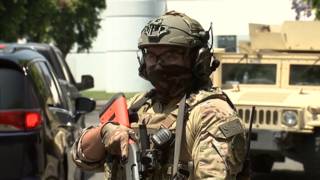
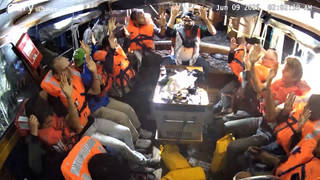
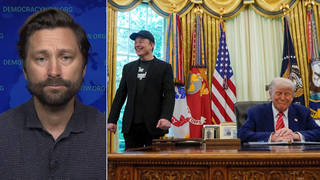
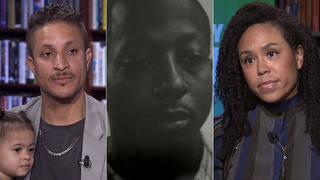
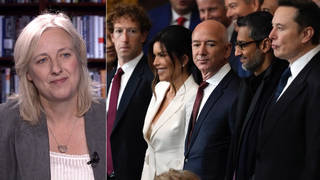
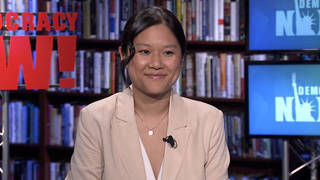
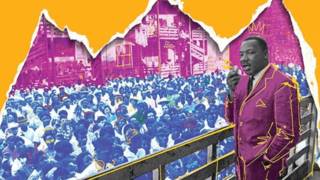

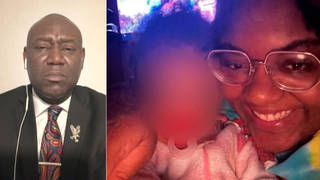

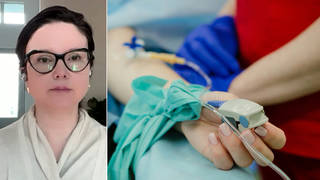
Media Options